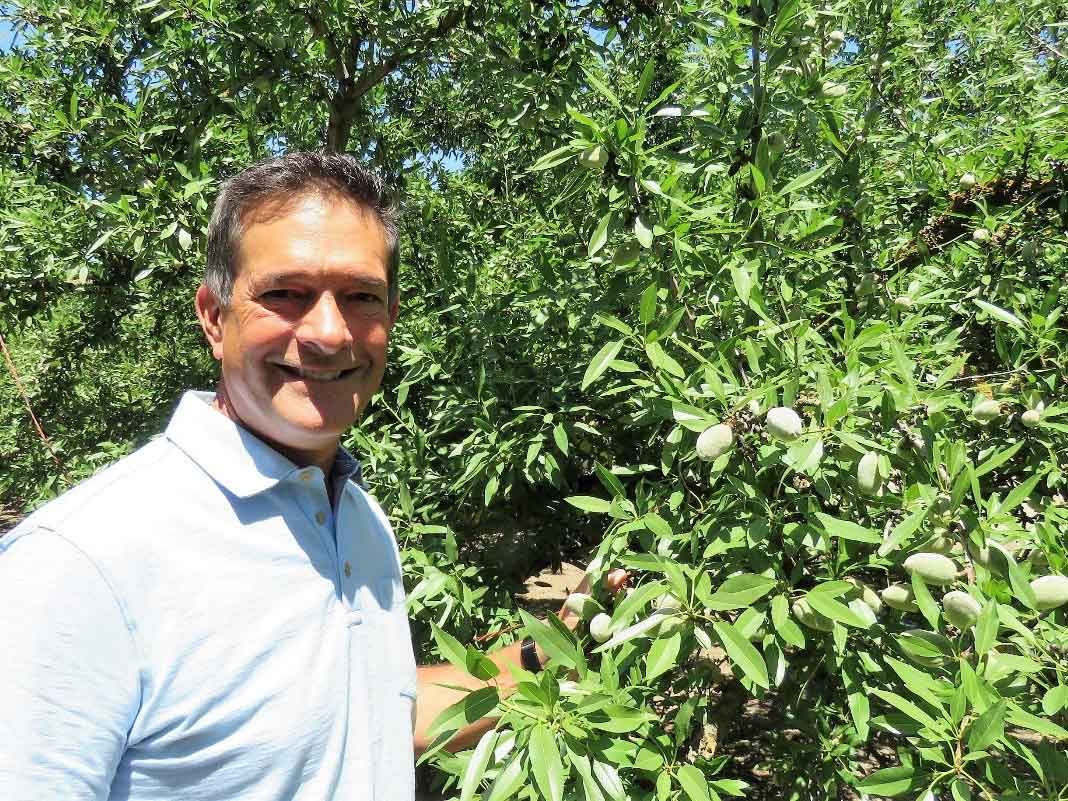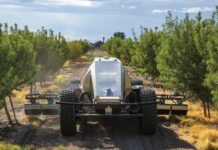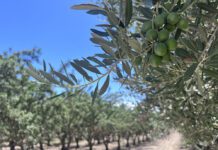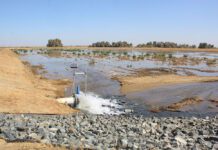
Have a conversation with grower and handler Ron Fisher about his values related to the almond business and you’ll notice a consistent theme: efficiency. The philosophy is one he’s embraced since 1986 when he formed Fisher Nut Company, and Fisher took that same efficiency acumen from his handler business and applied it to the almond growing operation he started in 2000.
Fisher, who now farms about 1,000 acres of almonds in Stanislaus and San Joaquin counties, said his team strives to work as efficiently as possible. “We want to be stewards of the land and water because environmental issues are important to us. At the same time, we want to maximize production, so we’re measuring twice and cutting once.”
Automated Irrigation System
Fisher’s adherence to doing more with less has led him to install a fully automated irrigation management system—but it wasn’t built overnight.
“It was an evolution,” Fisher said. “We started off with flood irrigation and then we went to double-lined drip and then to automation.”
Fisher’s journey to automated irrigation technology began in 2005 after he heard a pitch from a company touting the benefits of using improved technologies alongside an online monitoring system. Recognizing the potential savings, he installed automated clocks on his pumps and tensiometers in his orchards the following year. A few years later, Fisher installed soil moisture meters that report data on an hourly basis, followed by weather stations that measure in-orchard evapotranspiration (ET) rates.
“The automated system started with the automatic pump-start so we could use off-peak power and control run times of irrigation applications,” Fisher said. “It also included redundancy systems—which are fairly common today—so we know that if a pump went on that it’s actually pumping water.”
Online Monitoring
Fisher can log-in to the system from any device—his phone, tablet or desktop—to monitor all aspects of his irrigation including pressure sensor readings that show when water is in the line while the pump is running. Monitoring pressure is important, said Fisher, because if the pressure is off then there could be an issue, like a main break or no water in the canal.”
Included in his online monitoring reports is data from his in-orchard weather stations, which measure wind speed, temperature and other climate factors. With summer temperatures on the rise, Fisher can make changes to his irrigation scheduling online—and from anywhere—based on ET readings and available soil moisture.
“With hotter weather, ET is going up,” Fisher said. “I can make corrections on the website and I don’t have to run out to the ranch to make those changes. I can order water with a couple of keystrokes and the pump will start and stop.”
As an early adopter of automation technology, Fisher has seen more than a decades’ worth of benefits to his bottom line and operational efficiency. He can run his irrigation sets during off-peak hours, taking advantage of lower energy rates and creating consistent schedules with his irrigation district.
Efficiency Equals Savings
“Naturally, farmers want to irrigate when they’re awake and can utilize the water,” Fisher said. “With our automation, we can do it during off-peak hours, which saves costs and helps the utility system.”
Fisher also notes that his automated system allows him to be more efficient in managing ranches that are spread out across two counties, reducing the need to drive to different locations to manage water.
Software
Along with these benefits, Fisher has also seen an evolution and improvement in the automated irrigation technology that’s available to growers.
“Today, the software utilization has become easier and the on/off function of the pump-start is amazingly efficient,” he said.
Fisher also said the readability of different techniques within the software helps him identify and pinpoint problems sooner, which leads to quicker fixes.
“I can tell if there’s a break in the main line or if the gate hasn’t been opened properly,” he said. “In the old days, you’d have a dripline clog and all of a sudden you’d have a row of trees defoliate. This system helps prevent that.”
Automation and SGMA
Fisher believes that irrigation automation may have an increased role in the future, as water supplies will likely be tighter through regulations such as the Sustainable Groundwater Management Act (SGMA).
“I think automation can only help a grower because of the efficiencies it provides. If you’re able to control to the minute what you’re pumping and you’re evaluating what you’re pumping and the effect that it has on your trees, then you’re only going to get better with your application.”
While Fisher extols the benefits of automated irrigation, he said each farmer must make an individual decision to implement such a system based on their orchard’s needs as well as related costs. He knows this firsthand, as he’s chosen to utilize an automated system on 75 percent of his ranches, noting his smaller ranch will likely not install the system due to economic feasibility.
Online System Goes Down
The transition to irrigation automation might lead some growers to ask the question, “What happens if the online system goes down?” Fisher’s been there.
“If your system goes down, you don’t get your data, at which point you realize how spoiled you were to have it. The worst-case scenario is that you have to turn on the pump by hand, and you can always do that. You’re never going to replace the farmer’s footprints in the orchard. You have to be in the orchard no matter what technology you have.”
Ron Fisher operates at Level 3.0 of the Almond Board of California’s Almond Irrigation Improvement Continuum. Growers interested in learning more about the and would like to view a digital copy may visit the Almond Board of California’s website at Almonds.com/Irrigation















